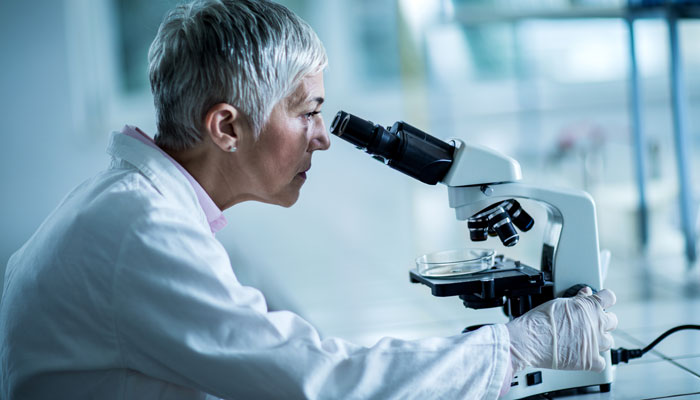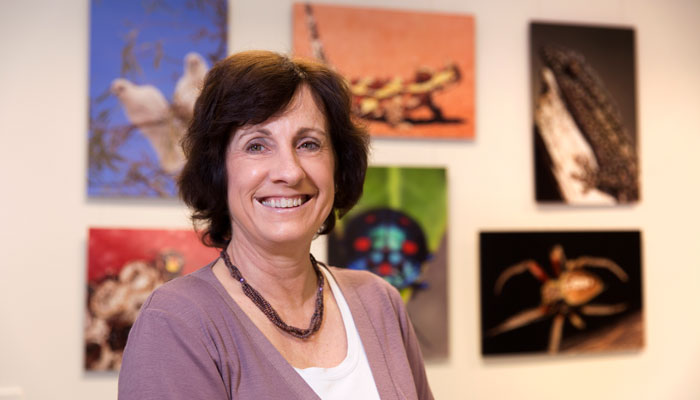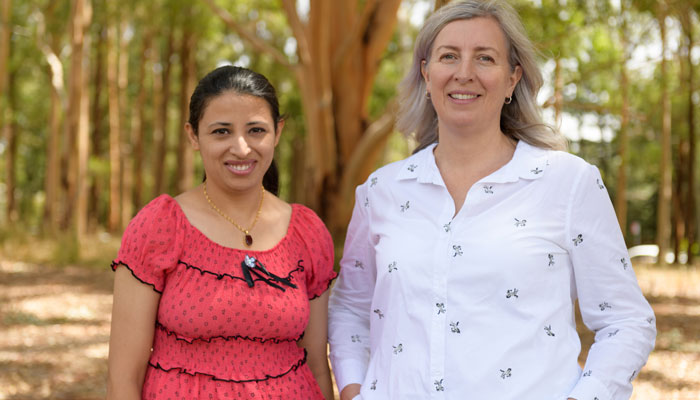Science continues to have low numbers of women in senior positions.
Women make up 33.1% of undergraduates, and 39.7% of PhD students in STEM (Science, Technology, Engineering and Maths). Of Australia’s nearly 20,000 academic and research-only staff, just 32% are women.
And it’s in senior roles that the disparity becomes stark; while women make up 41.7% of junior academics, they represent just 13.9% of senior Professors in STEM, according to 2014 DET figures released by SAGE (Science Gender Equity) in Australia.
To mark International Women’s Day 2019, we asked five prominent Macquarie University women what they think it will take to improve gender balance in science.
THE CHEMISTRY PROFESSOR
Professor Alison Rodger is a molecular chemist and Head of Department at Macquarie’s Department of Molecular Sciences. She joined Macquarie in 2017 after 20 years at the University of Warwick in the UK where she also spent four years on the Council of the Royal Society of Chemistry. Her research involves the interaction of biomolecules and she’s establishing an open access biophysical spectroscopy laboratory at Macquarie.

Numbers don't lie: Women make up only 33.1% of undergraduates, and 39.7% of PhD students in STEM (Science, Technology, Engineering and Maths). Of Australia’s nearly 20,000 academic and research-only staff, just 32% are women.
How has gender affected your career?
I spent 11 years of my career as the only female academic in my department - then I moved to Macquarie two years ago and inherited a department that's completely gender balanced from level A to level E.
Balance has been a good thing. I believe diversity – gender, race or whatever else - is the key to not getting stuck in a rut. When there’s ‘critical mass,’ individuals aren’t isolated. If there’s one woman in the department, everybody tends to explain your actions as, that's women. When you've got 50/50, it just becomes – that’s Jane or Mary or Fred or Sam, and so individuals can be individuals without being the type for whatever they're representing.
What needs to happen to achieve gender balance in science?
An interesting Harvard Business School study showed that if your interview shortlist had at least two women on it, the women were much more likely to get appointed because instead of comparing women to men, the women could be compared against each other as well. I believe that wherever possible we should have more than just a very limited representation.
I’d also like recruiters to think about gender much earlier in the pipeline - by looking for women already in positions of leadership, they are just moving pieces around.
Macquarie has systemically revised the promotion process rather than rushing around trying to do bits and pieces here and there. We do need to think about the system of how women get into leadership. The next challenge is getting the appointments process and the personal development and annual review process lined up.
I’d also like recruiters to think about gender much earlier in the pipeline. I'm frequently contacted by people either wanting to put me on their shortlist or for me to list women that they can approach. But by looking for the women already in positions of leadership, they are just moving pieces around – if Macquarie gets one, someone else loses her. Scientific companies and research bodies need to work out how to enhance the pipeline.
In general, one can take a ‘fix the women’ or ‘fix the system’ approach. The ‘fix the women’ approach is widely damned in the literature. But there is an element to which I think we need some of both. Academia is intrinsically a competitive activity where you are constantly submitting your papers to be reviewed and rejected, your grant proposals to be reviewed and rejected and so on. On average women tend to be somewhat less competitive and somewhat better at working collaboratively than men – so while we can change the culture, everyone needs to have the skills to succeed.
THE GEOLOGIST
Professor Dorrit Jacob is a geologist and mineralogist and Head of Department at Macquarie’s Department of Earth and Planetary Sciences. She joined Macquarie as an ARC Future Fellow in 2013 and was promoted to Professor in 2016. Prior to that she was a Professor at Johannes Gutenberg-University in Mainz, Germany.
In my previous role in Germany, I was the only female Professor that the Geology Department had appointed since it was founded in 1945.
Her research explores carbonate biominerals such as mussel shells, used for paleoclimate reconstructions, and also analyses rock formations including diamonds formed deep within the earth’s crust.

Equity evolution: Professor Jacob says she sees significant cultural change among young scientists compared with her own early experiences where it was difficult to be the the only woman in a group of men.
How has gender affected your career?
Geology is quite a male dominated field. In my previous role in Germany, I was the only female Professor that the Geology Department had appointed since it was founded in 1945. Macquarie is doing much better in that respect, about 30 per cent of my department are women and I’m currently the female Head of Department.
The leadership culture in a male-dominated area is quite different. When you’re the only woman in a group of men, it’s difficult to stay true to yourself. I found it hard not to adopt a more male style body language for example. But you persist and make small changes to the culture, and then you wait for the next wave and the critical mass before you can make the bigger changes. I’m now seeing significant cultural change – and it’s generational. Young scientists, irrespective of gender, now have the same expectations of a similar career pathway. In my generation, there was a focus on childcare as a way to get equity, that’s a long way down the list now.
What needs to happen to achieve gender balance in science?
It's a dilemma - Europe has experimented with quotas, and in Germany, there must be female appointments up to a certain percentage, but that also gives you some backlash – and questions about quality of candidates. Sometimes it comes down to things like families rather than women. Making the situation better to accommodate childcare, to not have meetings after kindy closes, things like this, everyone benefits and the whole climate in the Department becomes more inclusive and more tolerant.
Having more women in leadership is good for role modelling but I don’t think we should expect all women in these positions to be mentors - some women in leadership positions are not good mentors, because they made a system that is dominated by men work for them; and some have adapted so much that they don't feel the need to change anything. Mentors should be self-selecting. Many senior women want to open the doors for more women, but some do not and sometimes don’t even acknowledge there’s a problem.
Attending conference sessions on gender I’ve found it so interesting to see the differences when there are three or four generations of researchers. Today’s doctoral students have really normal attitudes to gender equity, and good expectations, and it’s not just young women but also young men, growing up into people who respect equality.
THE PRO VICE CHANCELLOR
Professor Lesley Hughes is Distinguished Professor of Biological Science,and the Pro Vice-Chancellor (Research Integrity and Development) at Macquarie.

Positive experience: Professor Lesley Hughes says she has had many opportunities despite working in a male dominated field.
An ecologist who researches the impacts of climate change on species and ecosystems, and the implications of climate change on the applied issues of land management and conservation policy in Australia and elsewhere, Professor Hughes was also a lead author for the UN’s IPCC Fourth and Fifth Assessment Reports.
How has gender affected your own career?
Positively (I think)! I began researching climate change before it became such a hot topic and as government advisory bodies and other institutions got more involved, I’m fairly sure I was offered opportunities because in a field that was full of men, I was one of the few women with research credentials (there’s probably other opportunities that I missed out on because I was a woman but I'll never know about those!). I think that if you do a reasonable job and get on with people, opportunities lead to more opportunities.
Our approach at Macquarie with gender equity in general (not just women in STEM) is to fix the system not the women. We are identifying the systemic institutional barriers to women's progression and trying to fix those.
What needs to happen to achieve gender balance in science?
We are tackling gender equity at Macquarie (including women in STEM) by “fixing the system”, rather than the more usual approach of “fixing the women”. We don’t buy into the deficit model that underpins many approaches to equity – like running assertiveness training, or developing specific mentoring and leadership courses for women. Instead, we believe that we need to create a system that provides opportunities for all talented people, regardless of gender.
So we are taking a data-driven, evidence-based approach to identify the systemic institutional barriers to women's progression and working to fix those. For example, we know that the proportion of women academics drops off very steeply between Levels B and C (lecturer to senior lecturer).
We are breaking this problem down, asking for example, whether this is an issue of lack of recruitment, or lack of promotion, or a lack of support for family breaks, or a combination of these and other factors. By identifying the specific barriers to progression, and changing policies to break these barriers down, we hope to create not just the institutional structures that promote equity, but also an inclusive culture that supports diversity more broadly.
THE YOUNG SCIENTIST
Dr Tayyaba Zafar is an astronomer working in the new Australian Astronomical Optics (AAO) team at Macquarie. Her research explores the interstellar medium to study gas, metals and dust in galaxies. As a Macquarie ‘Superstar of STEM,’

From astronomy to Antarctica: Dr Tayyaba Zafar and colleague Dr Katrina Sealey will this year visit Sydney schools and Skype young women in disadvantaged areas to encourage them to think about careers in STEM.
Dr Zafar has just completed a year-long program designed to turn her (and colleague Dr Katrina Sealey) into role models and mentors for young women in science. Her training included a trip to Antarctica and this year will visit schools and Skype young women in disadvantaged areas to encourage girls to think about careers in STEM.
How has gender affected your own career?
My research area is an emerging field, so there are very few astronomers working on that and most are men. Overall in astronomy, we have less women. Many of my female colleagues who were doing an excellent job in astronomy have left. I feel we need to do more to keep women in astronomy and in STEM because often they give up because their husbands have to move for example. It’s during the middle of a woman’s career that we see these ups and downs and that’s where we need to focus some efforts.
What needs to happen to achieve gender balance in science?
Society needs to accept the career ‘up and down’ phases, particularly for women, and also to identify mid-career women who are considering returning, and to mentor them. A lot of mentoring targets early career researchers but I think women may need mentorship several times over their careers in science.
The real key to having more women in leadership anywhere is diversity and flexibility. Organisations need to be more flexible and admit that, yes, women have more different challenges than man. We also need to work on organisations, to keep their diversity, be willing to consider job sharing or flexible positions. That’s not to say that they can expect less from women – no! Women are capable on every front but at some stages, things just roll more slowly.
THE DIRECTOR OF HUMAN RESOURCES
Ms Nicole Gower joined Macquarie as Director of Human Resources in 2014 after working in senior HR roles at the University of New South Wales and in private sector employment law. She’s the Macquarie University Executive Group sponsor for strategic initiatives including the Gender Equity Strategy and has a particular interest and passion for leadership development and talent strategy in an academic context.

Success story: HR Director Nicole Gower is proud of a recent recruitment exercise in the School of Engineering which set out to remove gendered language and address unconscious bias - women academic staff numbers rose from five per cent to 25 per cent.
How has gender affected your own career?
Law is a professional field dominated by men, and I’ve been fortunate to work with some wonderful role models (both men and women), who mentored and sponsored my development. These relationships are so important. When I did experience challenges, they were around everyday sexism and sexual harassment, particularly as a young female lawyer.
I have just lodged my submission to the Human Rights Commission’s Inquiry into Sexual Harassment in the hope that Australia can build a more inclusive and respectful work environment for everyone. Macquarie leads the way with gender equity and inclusion, and I’m highly motivated for Macquarie to extend our lead and be a role model for other organisations and the community.
Culture is key. Ensuring an inclusive, respectful working environment for everyone (not just women) is crucial to success.
What needs to happen to achieve gender balance in science?
The world of science has come a long way, but progress is not even across the board and there is still a long way to go. At Macquarie, our approach is to “fix the system” rather than trying to change the individuals that operate within those systems. That means reviewing our work systems, promotion pathways and culture to ensure they are free from bias and inclusive.
A great example is a recent recruitment exercise in our School of Engineering, which set out to remove gendered language and address unconscious bias. After positions were advertised, leaders used their networks to identify promising candidates and encourage them to apply, then committed to interviewing all women on the long-lists. The result: women in the School rose from 5 percent to 25 percent of academic staff within six months.
Culture is key. Ensuring an inclusive, respectful working environment for everyone (not just women) is crucial to success. We also know from our data analysis that career breaks can be challenging in the world of science, not just during parental leave, but also when returning to work with young children.
I know that from my own experiences. At Macquarie, we have put in place initiatives to specifically address these challenges and provide better support around these times. I also believe that leaders and role models have an important role to play.



